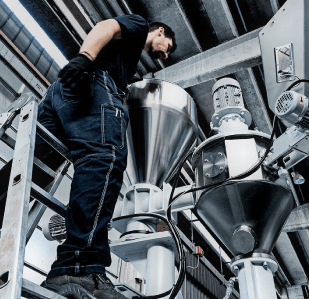Brief summary
Machine downtime, caused by unexpected failures or scheduled maintenance, can slow down production, increase costs, and create delivery delays. In this article, you'll learn how to calculate downtime, the main causes behind it, and the best strategies to prevent it, along with the risks it poses to your business, such as losing customers and damaging your reputation.
What is machine downtime?
Machine downtime refers to the period when equipment is not functioning, either due to scheduled maintenance or unplanned failures. Downtime directly impacts production as it halts the manufacturing process, leading to delays and inefficiencies.
Effects of downtime on manufacturing productivity
Downtime drastically reduces productivity by interrupting the workflow, increasing idle time for workers, and affecting the overall production output. It also increases operational costs, disrupts the supply chain, and decreases overall equipment effectiveness (OEE).
-
How to calculate unplanned machine downtime?
Unplanned machine downtime can be calculated by subtracting the actual productive hours from the total scheduled operating time. It is often expressed as a percentage of total time, giving an overview of how much downtime is impacting production.
For example:

This formula helps manufacturers quantify the loss of productivity due to unplanned events.
Risks of downtime manufacturing
One of the key risks of downtime is the need for technical assistance. Waiting for technical support, especially in the event of complex malfunctions, prolongs downtime and disrupts production schedules.
A lack of available spare parts can significantly extend downtime, especially when parts need to be ordered. Lead times for receiving and installing parts delay repairs, further affecting productivity.
When machines are down, employees may be idle, which translates into wasted labor costs. Overtime work might be required to make up for lost time, further driving up costs.
-
Overload of other departments
Downtime often results in overloading other departments. Teams may be forced to overwork to compensate for lost production time, which can lead to errors, increased equipment wear, and a greater likelihood of future failures.
To mitigate the impact of downtime, manufacturers may resort to outsourcing production. While this might solve short-term problems, it increases production costs and complicates logistics.
When production is delayed due to downtime, it can lead to late deliveries to customers, resulting in penalties, loss of contracts, or strained business relationships.
Consistent downtime and delayed deliveries can harm the company's reputation. Customers may seek more reliable suppliers, leading to lost business opportunities and a damaged brand image.
What are the common causes of equipment downtime?
-
Mechanical failures: Breakdowns due to wear and tear.
-
Operator errors: Mistakes during operation or setup.
-
Lack of maintenance: Skipped preventive maintenance can lead to unexpected malfunctions.
-
Software malfunctions: Glitches in software controlling the equipment.
-
Supply chain issues: Delay in getting necessary materials or parts.
-
Environmental factors: Extreme temperatures or poor factory conditions.
How can machine downtime be prevented or reduced?
Preventing downtime requires proactive strategies:
-
Regular maintenance: Scheduled maintenance helps to detect and resolve issues before they lead to a breakdown.
-
Monitoring and diagnostics: Using sensors and IoT technology can help in real-time monitoring of equipment performance, predicting issues before they arise.
-
Operator training: Well-trained staff are less likely to make errors that lead to downtime.
-
Spare parts inventory: Keeping critical spare parts in stock minimizes delays in repairs.
-
Automation: Automated systems can reduce the likelihood of human error and keep the production process running smoothly.



_5f105f2e7dff4.jpeg)



